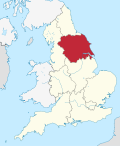North Holderness Light Railway
53°57′47″N 0°19′48″W / 53.963°N 0.330°W
North Holderness Light Railway (Never constructed) | |||||||||||||||||||||||||||||||||||||||||||||||||||||||||||||||||||||||||||||
|---|---|---|---|---|---|---|---|---|---|---|---|---|---|---|---|---|---|---|---|---|---|---|---|---|---|---|---|---|---|---|---|---|---|---|---|---|---|---|---|---|---|---|---|---|---|---|---|---|---|---|---|---|---|---|---|---|---|---|---|---|---|---|---|---|---|---|---|---|---|---|---|---|---|---|---|---|---|
| |||||||||||||||||||||||||||||||||||||||||||||||||||||||||||||||||||||||||||||

The North Holderness Light Railway was a proposed light railway, which was to have been constructed by the North Eastern Railway (NER) between Beverley and North Frodingham, in the East Riding of Yorkshire, England. The scheme was given parliamentary approval in September 1898 (under the Light Railways Act) for a line extending to 12.5 miles (20.1 km).[1]
The line would have begun from a junction with the Hull to Scarborough Line, slightly to the north of Beverley railway station, and served villages and agricultural land in the Holderness area. Stations were proposed at Tickton, Routh, Long Riston, Leven, Brandesburton and North Frodingham. At North Frodingham the line would have shared a station with a separate light railway, the Bridlington and North Frodingham (also never built), running to Carnaby on the Hull to Scarborough Line.[2]
The NER abandoned the plans for the North Holderness line in 1903 and a bus service was provided instead, connecting Beverley to North Frodingham and then continuing to Driffield. Buses began running on 7 September 1903 and the route was the second bus service to be operated by a British railway company.[2] The service continued to be run by the NER and its successor, the London and North Eastern Railway, until 1933 when it was sold to a local bus company.[3]
Plans for a railway were later reconsidered, though with the line built to a narrower gauge than standard gauge on account of some of the marshy land that the line would have to cross,[4] and in 1919 Darlington Works designed a 2 ft (610 mm) gauge tank locomotive.[2]
The route was shown on tiled maps of the North Eastern Railway network at some of their stations.[5] These maps are still extant at Beverley, Hartlepool, Middlesbrough, Saltburn, Scarborough, Tynemouth, Whitby and York.[6] An example can also be seen at the National Railway Museum.[7]
References
- ^ Bosley, Peter (1990). Light railways in England and Wales. Manchester: Manchester University Press. p. 183. ISBN 9780719017582. Retrieved 12 April 2025.
- ^ a b c Hoole, K. (1986). A Regional History of the Railways of Great Britain: Volume 4 The North East (Third ed.). David St John Thomas. pp. 60–62. ISBN 0 946537 31 3. Retrieved 15 April 2025.
- ^ Klapper, Charles F. (1978). Golden Age of Buses. Routledge & Kegan Paul. p. 136. ISBN 0-7102-0232-6. Retrieved 15 April 2025.
- ^ Mason, P. G. (1990). Lost Railways of East Yorkshire. Driffield: Wold Publications. pp. 63–65. ISBN 0-9518832-1-6.
- ^ Hoole, K. (1985). Railway Stations of the North East. David & Charles. p. 20. ISBN 0-7153-8527-5. Retrieved 15 April 2025.
- ^ "Tile Gazetteer - Yorkshire". Tile & Architectural Ceramics Society. 2005. Retrieved 15 April 2025.
- ^ "Ceramic tile map of North Eastern Railway". Science Museum Group. Retrieved 15 April 2025.
Further reading
- Limon, Martin (November 2006). Tales From the East Riding. Tempus Publishing. ISBN 0-7524-4038-1.

